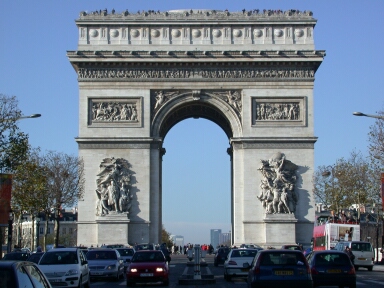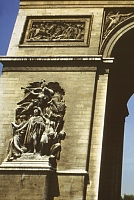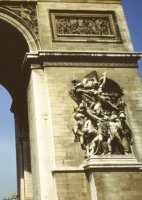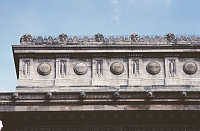
Arc de Triomphe
 |
Purpose and Historical Context: Napoleon, was a French emperor who conquered most of Europe at the beginning of the 18 hundreds. Napoleon had seen and liked the arches built by the Romans that were constructed so that victorious roman Emperors could hold parades. Napoleon like this idea, so he ordered the arch to be built in 1806; the original Architect was Jean Francois Therese Chalgrin, but both Chalgrin and Napoleon died many years before the arch was completed. Work on the arc stopped when Napoleon was defeated in 1814. The contruction of the arch started up again in 1833 under the ruling of "King Louis-Philippe the first" and completed in 1836. The king dedicated the arch to the glory of France’s armed forces. Today the Arc de Triomphe keeps the memory of all the dead killed in World War 1 with the grave of the unknown soldier and a permanently burning flame of remembrance. On national days a flag is stretched through the arch. |
Location, Materials and Style: The monument is located on the hill of Chaillot at the center of a star shaped configuration of twelve radiating avenues. The arch measures fifty meters in height and fourty five meters in width. The sides of the are decorated with detailed sculptures of battles. Inside of the arch, are the names of all the 128 victorious battles and a list of the 550 generals of Napoleans army. The architect Jean Francois Therese Chalgrin's creation is twice the size of the ancient roman Arch of Titus, from which it was modelled. The Arch de Triomphe is the worlds largest triumphal arch and is considered to be a land mark in Pairs because, of its mass, its beauty and the fact that twelve streets merge on its very location; this creates a star-like appearance from above. |
 |
This relief sculpture is called 'The triumph of Napoleon'. The scene displays Napoleon in victory as a town surrenders before him. |
| This relief is called 'La Marseillaise'. The relief displays the french people rallying against enemies; because of these people showing so much patriotism it became known as the french national anthem, 'La Marseillaise'. |  |
 |
The attic is decorated with thirty shields. Each shield has a name of a important victory or battle inscribed on it. |